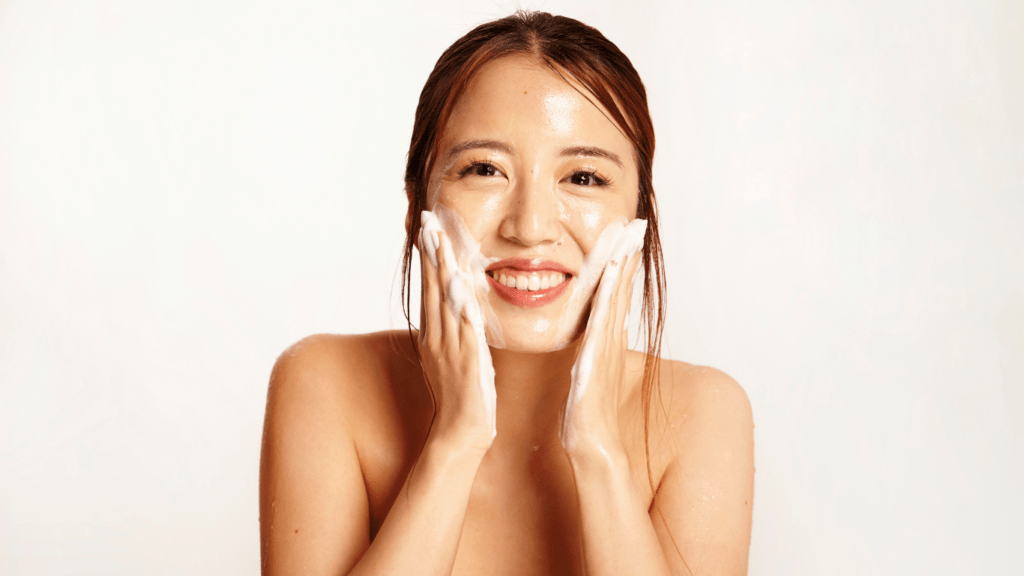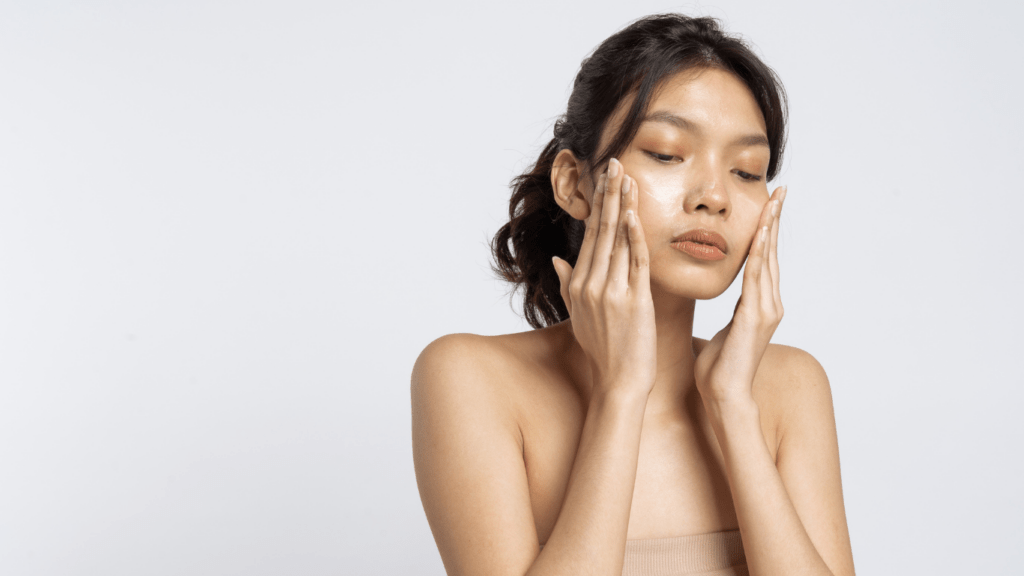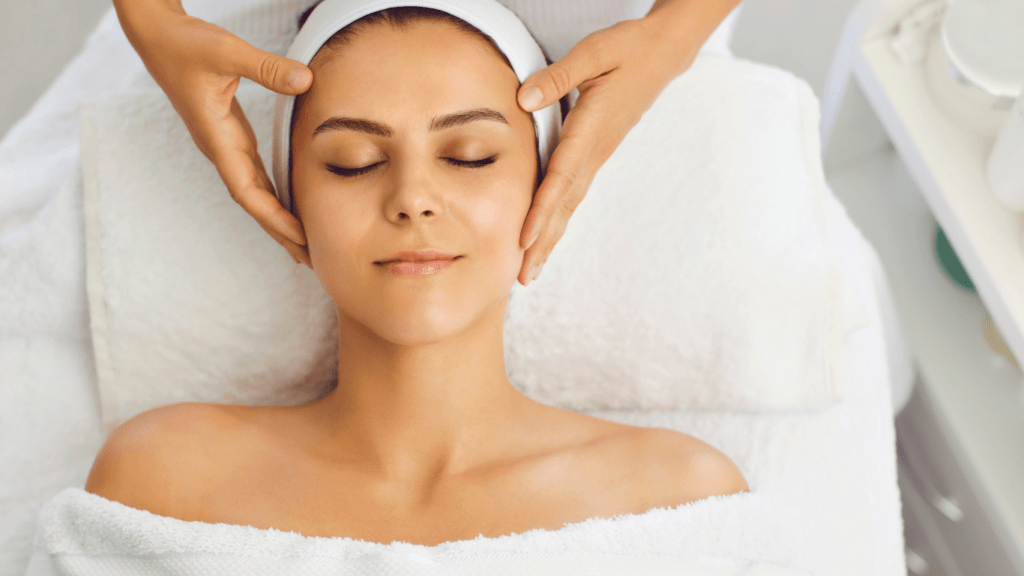Understanding Your Skin Type
Recognizing your skin type is essential for creating a skincare routine that benefits your complexion. I identify five primary skin types: normal, oily, dry, combination, and sensitive.
- Normal Skin
Normal skin maintains balance without being too oily or too dry. It’s generally free from acne, with few imperfections. If your skin feels comfortable and not too tight or greasy, you likely have normal skin. - Oily Skin
Oily skin produces excess sebum, leading to a shiny appearance and larger pores. This skin type is prone to acne and blackheads. If your skin becomes greasy throughout the day, you might have oily skin. - Dry Skin
Dry skin lacks sufficient moisture and feels tight, especially after cleansing. It may exhibit flaky patches and rough texture. If your skin often feels parched and uncomfortable, it’s likely dry. - Combination Skin
Combination skin features both oily and dry areas. The T-zone (forehead, nose, chin) typically becomes oily, while cheeks stay dry. If you notice varying textures on different parts of your face, you probably have combination skin. - Sensitive Skin
Sensitive skin reacts easily to products and environmental factors. It may become red, itchy, or inflamed. If your skin often feels irritated or reacts strongly to new products, you have sensitive skin.
Identifying your skin type allows me to select products that cater specifically to my skin’s needs, helping achieve optimal results in my skincare routine.
Step 1: Cleansing

Cleansing is the foundation of any skincare routine. It removes dirt, oil, and impurities, setting the stage for the next steps.
Importance of Cleansing
Cleansing improves skin health by eliminating pollutants. This prevents clogged pores which can lead to acne, blackheads, and other skin issues. Clean skin enhances the effectiveness of subsequent skincare products by allowing them to penetrate more deeply.
Best Cleansers for Different Skin Types
Choosing the right cleanser based on skin type maximizes results.
- Normal Skin: Gel-based or foaming cleansers work well. They help maintain the skin’s natural balance without stripping essential oils.
- Oily Skin: Foaming or clay-based cleansers can control excess oil and reduce shine.
- Dry Skin: Cream or oil-based cleansers provide hydration and avoid over-drying the skin.
- Combination Skin: Gel cleansers balance different areas, avoiding exacerbating oiliness or dryness.
- Sensitive Skin: Hypoallergenic and fragrance-free cleansers minimize irritation and soothe the skin.
Step 2: Exfoliating
Exfoliating removes dead skin cells, revealing fresher, smoother skin. It’s essential for maintaining a clear complexion and enhancing product absorption.
How Often to Exfoliate
Exfoliating frequency depends on your skin type. I recommend exfoliating twice a week for normal and combination skin types, as it strikes a balance between effectiveness and sensitivity. For those with oily skin, exfoliating three times a week helps control excess oil and prevents clogged pores. Dry or sensitive skin types should exfoliate just once a week to avoid irritation. Always adjust based on your skin’s response to avoid over-exfoliating, which can cause redness and sensitivity.
Recommended Exfoliants
Choosing the right exfoliant depends on your skin’s needs and tolerance. For normal and combination skin, I suggest AHA (Alpha Hydroxy Acid) products like glycolic acid, which gently exfoliates without over-drying. Oily skin benefits from BHA (Beta Hydroxy Acid) products, such as salicylic acid, known for penetrating pores and reducing sebum. Dry skin responds well to enzyme exfoliants, which break down dead skin cells without physical abrasion. Sensitive skin types should opt for gentle, physical exfoliants like finely ground oatmeal or non-abrasive scrubs to minimize irritation. Always patch-test new products to ensure compatibility with your skin.
Step 3: Toning
Toning balances the skin’s pH and preps it for better absorption of subsequent skincare products. Proper toning promotes hydration and minimizes the appearance of pores.
Benefits of Using Toner
Toner restores the natural pH level of the skin, which can be disrupted by cleansing. A balanced pH helps protect against environmental stressors and bacteria. Using toner after exfoliating also tightens pores, giving skin a smoother appearance. Additionally, toners infused with antioxidants and peptides provide extra skin benefits and enhance its overall health.
Choosing the Right Toner
Select a toner that matches your skin type and addresses specific skin concerns. For oily and acne-prone skin, choose a toner with salicylic acid to help control excess oil and clear pores. For dry or sensitive skin, look for alcohol-free toners with hydrating ingredients like glycerin or hyaluronic acid to add moisture without irritation. Combination skin benefits from gentle, balancing toners that don’t over-dry any part of the face. Read ingredient lists to avoid harsh chemicals that could cause adverse reactions.
Step 4: Applying Serum
Serums are vital in a skincare routine, adding concentrated active ingredients that address specific concerns.
Why Serums Are Essential
Serums provide targeted treatments directly to the skin. They’re formulated with higher concentrations of active ingredients compared to moisturizers. This allows them to address issues like fine lines, pigmentation, and dehydration more effectively. Since serums have smaller molecules, they penetrate deeper layers of the skin.
Types of Serums
Different serums tackle various skin concerns.
- Vitamin C Serums: Brighten complexion and protect against environmental damage.
- Hyaluronic Acid Serums: Improve hydration by drawing moisture into the skin.
- Retinol Serums: Boost collagen production and reduce signs of aging.
- Niacinamide Serums: Reduce inflammation and help with acne.
- Peptide Serums: Support skin’s structural integrity, promoting firmness.
Select a serum tailored to your skin’s needs for optimal results.
Step 5: Moisturizing
Moisturizing locks in hydration, ensuring your skin stays soft and supple. It’s essential for all skin types, even oily skin.
Hydration Tips for Different Skin Types
Choosing the right moisturizer depends on your skin type:
- Dry Skin: Thicker, cream-based moisturizers work best. Look for ingredients like hyaluronic acid, glycerin, and ceramides to deeply hydrate and restore the skin barrier.
- Oily Skin: Lightweight, oil-free, gel-based moisturizers are ideal. Ingredients like glycerin and hyaluronic acid provide hydration without adding extra oil.
- Combination Skin: Use a gel-based moisturizer in the T-zone and a cream-based one on dry areas. Balancing hydration is key to managing combination skin.
- Sensitive Skin: Opt for fragrance-free, hypoallergenic moisturizers to avoid irritation. Ingredients like aloe vera and chamomile soothe sensitive skin.
Best Moisturizers on the Market
Here are top-rated moisturizers, suitable for various skin types:
| Skin Type | Moisturizer | Key Ingredients |
|---|---|---|
| Dry Skin | CeraVe Moisturizing Cream | Hyaluronic Acid, Ceramides |
| Oily Skin | Neutrogena Hydro Boost Water Gel | Hyaluronic Acid, Glycerin |
| Combination Skin | Clinique Moisture Surge 72-Hour Hydrator | Auto-Replenishing Lipid-Filler |
| Sensitive Skin | Aveeno Ultra-Calming Daily Moisturizer | Feversfew, Glycerin |
| Normal Skin | Olay Regenerist Micro-Sculpting Cream | Amino-Peptides, Hyaluronic Acid |
Effective moisturizing enhances the benefits of previously applied serums and protects your skin from environmental stressors.
Step 6: Eye Cream
Eye creams target delicate skin around the eyes, addressing issues like puffiness, dark circles, and fine lines. Incorporating an eye cream maximizes the benefits of the overall skincare routine.
Benefits of Eye Cream
Eye creams contain active ingredients that cater to specific concerns. Caffeine reduces puffiness by constricting blood vessels. Peptides aid in collagen production, minimizing fine lines. Vitamin K diminishes dark circles by improving circulation. These targeted ingredients ensure that eye creams tackle multiple issues simultaneously, providing noticeable improvements over time.
How to Apply Eye Cream Correctly
Apply eye cream with your ring finger to avoid excess pressure. Dispense a pea-sized amount and gently dot it along the orbital bone, starting from the inner corners and moving outward. Pat, don’t rub, to ensure the skin absorbs the product without irritation. Make sure to use the cream twice daily, once in the morning and once at night, for optimal results.
Step 7: Sun Protection
Sun protection ranks as a critical step in any skincare routine. Sunscreen shields the skin from harmful UV rays.
Importance of Sunscreen
Sunscreen prevents skin damage, including sunburn, premature aging, and skin cancer. Skin cancer affects an estimated one in five Americans (source: Skin Cancer Foundation). Even on cloudy days, UV rays penetrate clouds, affecting the skin. Consistently applying sunscreen can reduce the risk of UV-induced damage.
How to Choose the Right SPF
When selecting a sunscreen, check for broad-spectrum protection to guard against UVA and UVB rays. Broad-spectrum types offer comprehensive defense. Aim for an SPF of 30 or higher, which blocks about 97% of UVB rays. Active ingredients like Zinc Oxide and Titanium Dioxide provide effective sunblock. For oily or acne-prone skin, consider a lightweight, non-comedogenic formula to avoid clogging pores. Reapply at least every two hours or after swimming or sweating for optimal protection.
Step 8: Face Masks
Face masks provide an excellent way to give your skin an extra boost. They offer intensive treatments targeting specific concerns.
Types of Face Masks
Various face masks suit different skin types and issues:
- Clay Masks: Ideal for oily and acne-prone skin, clay masks (Bentonite, Kaolin) absorb excess oil and impurities.
- Sheet Masks: Great for hydration, these masks deliver moisture and nutrients directly to the skin.
- Gel Masks: Suitable for sensitive skin, gel masks (Aloe Vera, Chamomile) provide a cooling and calming effect.
- Exfoliating Masks: Containing AHAs or BHAs, these masks lift dead skin cells, enhancing skin texture and radiance.
- Cream Masks: Best for dry skin, cream masks (Hyaluronic Acid, Shea Butter) deeply moisturize and nourish.
When to Use Face Masks
Integrate face masks 1-2 times weekly for optimal results. Apply masks after cleansing and before other skincare steps to ensure maximum absorption of nutrients. Adjust frequency based on your skin’s needs to avoid overuse and irritation.
Step 9: Spot Treatment
Spot treatments target specific blemishes or problem areas on the skin. They are essential for managing breakouts without irritating the surrounding skin.
Common Spot Treatments
Common spot treatments include benzoyl peroxide, salicylic acid, sulfur, and tea tree oil. Benzoyl peroxide targets acne-causing bacteria and reduces inflammation. Salicylic acid exfoliates and unclogs pores, ideal for blackheads and whiteheads. Sulfur removes dead skin cells and excess oil. Tea tree oil has natural antimicrobial properties, making it a gentle option for sensitive skin.
How to Apply Spot Treatments Effectively
Apply spot treatments directly to cleansed and dry skin. Use a small amount of product on the affected area. Limit application to the targeted spot to avoid unnecessary irritation. Let the treatment absorb completely before applying other skincare products. For best results, use spot treatments at night, ensuring they have enough time to work uninterrupted.
Step 10: Night Routine
A night routine is essential for skin recovery and rejuvenation. It allows products to work without interference from environmental stressors.
Differentiating Day and Night Routines
Day and night routines serve different purposes. Day routines focus on protection with sunscreen and antioxidants. In contrast, night routines target repair and hydration. During the day, skin faces pollutants and UV exposure. At night, skin enters a regenerative state, making it ideal for using potent products like retinoids and heavier moisturizers.
- Cleanser: A gentle, hydrating cleanser removes the day’s impurities without stripping moisture.
- Toner: An alcohol-free toner balances skin’s pH and preps it for subsequent products.
- Serum: Night serums with ingredients like retinol, peptides, or hyaluronic acid boost collagen production and hydration.
- Moisturizer: A rich moisturizer locks in hydration to prevent overnight moisture loss.
- Eye Cream: Eye creams with peptides or niacinamide reduce dark circles and puffiness.
- Overnight Mask: Use overnight masks for intensive hydration and to repair the skin barrier while sleeping.
By integrating these products into a night routine, skin can effectively repair and rejuvenate, helping to achieve a healthy, glowing complexion.


 Creative Director at Divine Glamour Trail, is the visionary behind the platform, which is dedicated to bringing readers the latest trends in hairstyles, beauty, and skincare. With a passion for timeless fashion and expert style guidance, George provides tips, secrets, and updates that empower individuals to enhance their personal style. His platform is a go-to source for anyone looking to stay ahead in the fashion game, combining modern trends with timeless elegance to help readers feel confident and look their best.
Creative Director at Divine Glamour Trail, is the visionary behind the platform, which is dedicated to bringing readers the latest trends in hairstyles, beauty, and skincare. With a passion for timeless fashion and expert style guidance, George provides tips, secrets, and updates that empower individuals to enhance their personal style. His platform is a go-to source for anyone looking to stay ahead in the fashion game, combining modern trends with timeless elegance to help readers feel confident and look their best.
